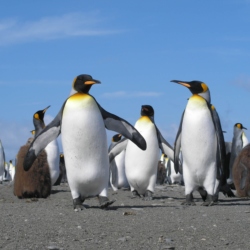 |
| King penguins walking; available on a refrigerator magnet from SGHT! Holiday cards, too, are in the giftshop online. |
Looking at the newest newsletter from the South Georgia Heritage Trust (pick it up at http://www.sght.org/sites/
But I have to say that what made me grin (and shiver!) was the photo of the swimming penguins in here -- why is it we so often see pictures of penguins walking on land (where their movements can seem awkward and "cute") and rarely the ones of penguins deftly at home in an ocean? Thanks, SGHT!
Interested in assisting human survival, as well as penguins? "Tis the season." Here's a letter from Partners In Health that reminded me of the "long tail" of disasters that strike the poorest regions. I've left a pair of live links embedded in it, in case you're in the mood to jump over to the PIH donation site.
It's been a year since cholera arrived on Haiti's soil. Today it is the largest cholera epidemic in the world.
In one year, it has infected 455,000 people -- a staggering 5% of Haiti's population. More than 6,500 people have died.
Today a heavy rainfall has more control over cholera in Haiti than those of us desperately seeking to stem its tide. But the truth is we know precisely how to control the cholera epidemic in Haiti.
We need your help to save lives in Haiti -- make a donation now.
Here's what needs to happen to bring cholera under control.
Short-term -- Help people NOW who are sick or threatened by:
Long-term -- Demand that the international community and the Government of Haiti create lasting change by:
- Finding cholera victims where they live and treating them at well-equipped, well-staffed facilities;
- Giving people the information they need to protect themselves, to know when they've been infected, and when, where, and how to get treatment;
- Providing emergency access to clean water and sanitation (latrines) to communities in most dire need;
- Launching a vaccination program that will save lives immediately and complement essential but longer-term efforts. (One estimate shows that 30% vaccination coverage in Haiti would decrease cholera cases by 55%.)
So what's stopping us? For one thing, there are fewer of us helping the sick.
- Guaranteeing clean water by digging wells, capping springs, and building safe water systems on a national scale;
- Treating waste through widespread access to latrines and waste treatment facilities.
In January 2010, the United Nations counted 128 national and international organizations responding to cholera in Haiti. In July 2011 that number dwindled to just 48. Worse, this reduction coincided with a quadrupling of cholera cases. In July, Zanmi Lasante treated 12,629 cholera patients. That's in addition to 1.8 million annual patient visits for births, malnutrition, pneumonia, cancer care, mental health, and other services that ZL provided even before cholera arrived on Haitian soil.
This is why I'm asking for your help.
The cholera epidemic demands response. So too does the misery of Haitians living in poverty and dying of preventable causes. Conscience demands that we respond to both. And we CAN.
If each of us steps forward to help, we can treat cholera, AND launch a vaccine program, AND continue providing the comprehensive health services on which millions of Haitians rely. We CAN do all these things and give Haiti the time it needs to make lasting change, but to do them we need your help.